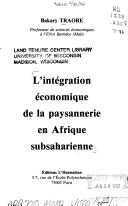| Listing 1 - 10 of 23 | << page >> |
Sort by
|

ISBN: 2738404715 9782738404718 Year: 1989 Publisher: Paris: L'Harmattan,
Abstract | Keywords | Export | Availability | Bookmark
 Loading...
Loading...Choose an application
- Reference Manager
- EndNote
- RefWorks (Direct export to RefWorks)
Book
Year: 1958 Publisher: Paris: Présence africaine,
Abstract | Keywords | Export | Availability | Bookmark
 Loading...
Loading...Choose an application
- Reference Manager
- EndNote
- RefWorks (Direct export to RefWorks)
Book
Year: 1958 Publisher: Paris : Présence africaine,
Abstract | Keywords | Export | Availability | Bookmark
 Loading...
Loading...Choose an application
- Reference Manager
- EndNote
- RefWorks (Direct export to RefWorks)
Book
Year: 1972 Publisher: Ibadan
Abstract | Keywords | Export | Availability | Bookmark
 Loading...
Loading...Choose an application
- Reference Manager
- EndNote
- RefWorks (Direct export to RefWorks)
Book
Year: 1958 Publisher: Paris : Présence africaine,
Abstract | Keywords | Export | Availability | Bookmark
 Loading...
Loading...Choose an application
- Reference Manager
- EndNote
- RefWorks (Direct export to RefWorks)
Book
Year: 1958 Publisher: Paris Présence africaine
Abstract | Keywords | Export | Availability | Bookmark
 Loading...
Loading...Choose an application
- Reference Manager
- EndNote
- RefWorks (Direct export to RefWorks)
Book
Year: 1958 Publisher: Paris Présence africaine
Abstract | Keywords | Export | Availability | Bookmark
 Loading...
Loading...Choose an application
- Reference Manager
- EndNote
- RefWorks (Direct export to RefWorks)
Book
Year: 1958 Publisher: Paris Présence africaine
Abstract | Keywords | Export | Availability | Bookmark
 Loading...
Loading...Choose an application
- Reference Manager
- EndNote
- RefWorks (Direct export to RefWorks)
Afrique --- Sociologie --- Théâtre
Book
Abstract | Keywords | Export | Availability | Bookmark
 Loading...
Loading...Choose an application
- Reference Manager
- EndNote
- RefWorks (Direct export to RefWorks)
Article
Abstract | Keywords | Export | Availability | Bookmark
 Loading...
Loading...Choose an application
- Reference Manager
- EndNote
- RefWorks (Direct export to RefWorks)
Most low-income countries export mainly unprocessed commodities. Yet, in their pursuit of structural transformation, they also seek a more diversified economic structure, including developing a strong manufacturing sector to create jobs and spur innovation as in more advanced economies. What is the best way for them to promote economic diversification? Should countries aim straight for anufacturing? Should they focus on the products most in line with their already-known and used endowments? Should they follow some sort of ladder of activities towards a well-diversified economy? Or should they simply lean back and let the markets sort it out? Finally, do the answers vary depending on the country? A body of recent research suggests that a country’s diversification process would tend to move along pathways of “nearby” products: the “new” products it specialises in would build on the existing productive capabilities and knowledge used to produce the “old” ones. It would follow then that low-income, raw commodity exporting countries should build on their naturalresource endowments. This would not always imply moving downstream and transforming those resources locally. Depending on learning processes, capabilities and the types of endowments, value addition at the local level may or may not make economic sense.
| Listing 1 - 10 of 23 | << page >> |
Sort by
|

 Search
Search Feedback
Feedback About UniCat
About UniCat  Help
Help News
News